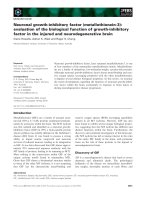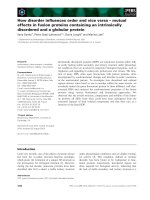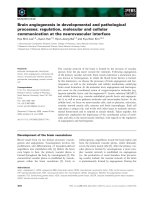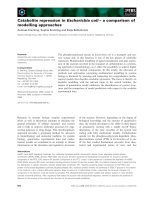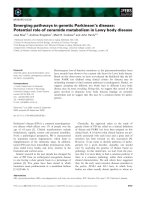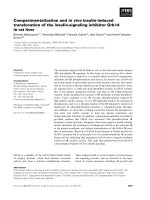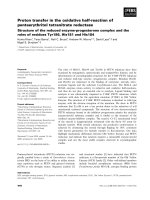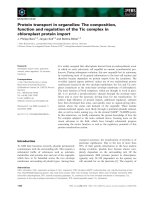Báo cáo khoa hoc:" Body composition in male elite athletes, comparison of bioelectrical impedance spectroscopy with dual energy X-ray absorptiometry" pdf
Bạn đang xem bản rút gọn của tài liệu. Xem và tải ngay bản đầy đủ của tài liệu tại đây (341.66 KB, 5 trang )
BioMed Central
Page 1 of 5
(page number not for citation purposes)
Journal of Negative Results in
BioMedicine
Open Access
Research
Body composition in male elite athletes, comparison of bioelectrical
impedance spectroscopy with dual energy X-ray absorptiometry
Ulla Svantesson
1
, Martina Zander
2
, Sofia Klingberg
2
and Frode Slinde*
2,3
Address:
1
Institute of Neuroscience and Physiology, Sahlgrenska Academy, University of Gothenburg, Sweden,
2
Department of Clinical Nutrition,
Sahlgrenska Academy, University of Gothenburg, Sweden and
3
School of Life Sciences, University of Skövde, Skövde, Sweden
Email: Ulla Svantesson - ; Martina Zander - ;
Sofia Klingberg - ; Frode Slinde* -
* Corresponding author
Abstract
Background: The aim of this study was to compare body composition results from bioelectrical
spectroscopy (BIS) with results from dual energy X-ray absorptiometry (DXA) in a population of
male elite athletes. Body composition was assessed using DXA (Lunar Prodigy, GE Lunar Corp.,
Madison, USA) and BIS (Hydra 4200, Xitron Technologies Inc, San Diego, California, USA) at the
same occasion. Agreement between methods was assessed using paired t-tests and agreement-
plots.
Results: Thirty-three male elite athletes (soccer and ice hockey) were included in the study. The
results showed that BIS underestimates the proportion of fat mass by 4.6% points in the ice hockey
players. In soccer players the BIS resulted in a lower mean fat mass by 1.1% points. Agreement
between the methods at the individual level was highly variable.
Conclusion: Body composition results assessed by BIS in elite athletes should be interpreted with
caution, especially in individual subjects. BIS may present values of fat mass that is either higher or
lower than fat mass assessed by DXA, independent of true fat content of the individual.
Background
In many sports, the body composition of the individual
athlete plays an important role. Changes in body compo-
sition might be a marker of change in nutritional status.
Changes in body composition have been used as informa-
tion regarding the athlete's adaptation to different types of
training [1]. It has been shown that a high proportion of
body fat mass (FM) is related to a low power to weight-
ratio, reduced acceleration and increased energy expendi-
ture, while the opposite applies to a high proportion of fat
free mass (FFM) [2]. On the other hand, a low proportion
of body fat has also been shown to reduce performance
[3]. The optimal body composition varies between sports;
in precision sports such as golf, bowling and shooting, the
results are less dependent upon body composition as in
sports as soccer, gymnastics and figure skating [4]. Sudden
changes in body composition can be a sign of health
problems, the most known being the female athlete triad
[5]. It therefore seems crucial that coaches and other lead-
ers within sports have knowledge and equipment to assess
body composition. Such equipment should be cheap,
easy to transport, give reliable results, and should not
require large education effort. Such a method could be
bioelectric impedance spectroscopy (BIS).
Published: 22 January 2008
Journal of Negative Results in BioMedicine 2008, 7:1 doi:10.1186/1477-5751-7-1
Received: 13 August 2007
Accepted: 22 January 2008
This article is available from: />© 2008 Svantesson et al; licensee BioMed Central Ltd.
This is an Open Access article distributed under the terms of the Creative Commons Attribution License ( />),
which permits unrestricted use, distribution, and reproduction in any medium, provided the original work is properly cited.
Journal of Negative Results in BioMedicine 2008, 7:1 />Page 2 of 5
(page number not for citation purposes)
Our understanding of the composition of the human
body is based on chemical analysis of six human bodies
[6-9]. These analyses showed that the mean water content
of the human FFM is 724 g per kg FFM. This finding has
been confirmed in 50 guinea pigs [10]. Bioelectrical
impedance assessment (BIA) is one method to achieve an
estimation of total body water (TBW). BIA makes use of
the fact that impedance to electrical flow of an injected
current is related to the volume of the conductor (the
human body) and the square of the conductor's length
(height). Impedance is a measure of how electrical current
is lowed or stopped as it passes through a material. Tho-
masset [11] was the first to report a relation between body
water and electrical impedance. Hoffer et al. [12] devel-
oped the principle and demonstrated that total body
water determined by the tritiated water method was
strongly correlated (r = 0.92) with height
2
/impedance in
20 normal volunteers and 34 patients with varying diag-
nosis and hydration status. Since then, numerous valida-
tion studies have been published. Some validation studies
of BIA using linear models have been performed in ath-
letes, and most of these report good validity, but only on
group level [3,13-15]. BIA has been a widely adopted
method for body composition assessment, not only for
scientific purposes but also in clinics and leisure centres
[16].
A common used reference method for body composition
assessment is dual energy X-ray absorptiometry (DXA)
which also has been used in studies of athletes showing
high reproducibility [3,13]. DXA was originally developed
to examine bone mineral density and examines the body
in mm
3
dividing the human body in three parts: bone, fat-
and bone free (soft) tissue, and fat tissue. The European
Society for Clinical Nutrition and Metabolism recom-
mends DXA as reference method in body composition
studies [17].
BIS is one of the latest technical developments within this
area. It differs from the older methods by measuring
impedance using a spectrum of frequencies and calculates
body composition using non-linear mathematical models
[16]. BIS has not yet been explored in athletes. A method
to be used in the world of sports should also be valid on
the individual level. The aim of this study was therefore to
compare body composition results from bioelectrical
spectroscopy with results from dual energy X-ray absorp-
tiometry (DXA) in a population of male elite athletes.
Results
Characteristics of the different groups of athletes are pre-
sented in Table 1. The ice hockey players had statistical
significant higher body weight and BMI, compared to the
soccer players. All ice hockey players but five had a BMI >
25 kg/m
2
. Table 2 shows that BIS overestimate the
amount of fat-free mass and underestimate the amount of
fat mass, compared to the result from DXA. This is espe-
cially obvious among the ice hockey players showing a
statistically significant higher fat free mass, assessed by
BIS, compared to the soccer players. All participants had a
body fat content assessed by DXA < 20% of their body
weight.
The Bland-Altman plots presented in Figure 1 shows that
BIS underestimates the proportion of fat mass by 4.6%
points in the ice hockey players. In soccer players the BIS
resulted in a lower mean fat mass by 1.1% points. Agree-
ment between the methods at the individual level is
highly variable with the largest difference between meth-
ods seen in a male ice hockey player where BIS underesti-
mated the proportion of fat mass by 12.1% points. The
largest individual overestimation of fat mass by BIS was
found in a soccer player having a fat mass of 5% assessed
by DXA and 11% assessed by BIS, a difference of 6%
points.
Discussion
This study shows that BIS underestimates fat mass in a
group of male elite athletes compared to results from
DXA. It also seems that BIS has very low precision in esti-
mating body composition at an individual level, which
could be important information regarding the athlete's
adaptation to different types of training [1]. To our knowl-
edge, this is the first study reporting the validity of BIS in
elite athletes, and the technique of bioelectrical imped-
ance overall at an individual level in elite athletes. Fornetti
et al [3] found good agreement on group level between
BIA and DXA in a large sample of female athletes from
mixed sports. That was also the case in a study of female
dancers [15] and a study of female runners [14]. In these
Table 1: Characteristics of study subjects (mean (sd)).
All participants (n = 33) Ice hockey players (n = 16) Soccer players (n = 17)
Age (y) 24.8 (5.0) 25.6 (6.1) 24.1 (3.8)
Body weight (kg) 83.3 (7.2) 86.3 (5.3) 80.6 (7.7)*
Body height (cm) 183.6 (5.7) 183.7 (5.0) 183.5 (6.4)
BMI (kg/m
2
) 24.7 (1.5) 25.6 (1.2) 23.9 (1.3)*
* p < 0.05, unpaired t-test
Journal of Negative Results in BioMedicine 2008, 7:1 />Page 3 of 5
(page number not for citation purposes)
two studies, new prediction equations from BIA, based on
regression, were developed since the standard equations
did not perform well in the sample of athletes. The choice
of prediction equation has also been shown to be of
importance in elderly subjects [18]. We chose to use the
equation provided by the manufacturer of the BIS equip-
ment, since this probably would have been the fact in
daily practice within training facilities. New prediction
equations based on the BIS results were not been devel-
oped in the present study due to a small sample size. BIS
is also a more complex method, compared to BIA, result-
ing in a large amount of measuring variables, why an
equation derived from the current study would probably
not be a practical tool to be used out in the field – even
though a better validity could have been accomplished.
BIS showed better agreement with DXA in soccer players
than in ice hockey players. Segmental data from the DXA
showed that the ice-hockey players had larger arms com-
pared to the soccer players, both fat mass, fat free mass
and total mass (results not shown). This is not surprising
considering the nature of the sports. There were no differ-
ences in trunk and leg mass. This might affect the imped-
ance as the volume of the narrowest conductor (the arm)
was larger in the ice-hockey players. More important for
the differences between the two groups is probably the
fact that the soccer players had a more "normal" body
which might increase the probability for a prediction
equation based on a normal population to provide more
valid results.
In this study, DXA was used as reference method. Criti-
cism has even been raised concerning this method and
some studies have reported imprecision in body composi-
tion assessment [19-22]. A large problem seems to be
diversities between different devices and software. How-
ever, in this study, only one type of device and software
has been used. Even if, to our knowledge, DXA has not
been validated in a population of elite athletes, the impre-
cision shown in other populations have been small and
DXA is recommended as reference method in body com-
position assessment by The European Society for Clinical
Nutrition and Metabolism [17].
Results from the current study do not indicate that BIS
under- or overestimates fat mass in a systematic pattern.
The over- or underestimations do not follow the differ-
ences in body fat content of the individual (Figure 1). Skin
temperature, strenuous exercise, dehydration, and glyco-
gen depletion have been shown to affect results from
measurements of bioelectrical impedance [23,24]. All
Differences between proportion of fat mass assessed by BIS and DXA plotted against average of proportion of fat mass assessed by BIS and DXA in 17 male elite soccer players and 16 male elite ice hockey playersFigure 1
Differences between proportion of fat mass assessed by BIS
and DXA plotted against average of proportion of fat mass
assessed by BIS and DXA in 17 male elite soccer players and
16 male elite ice hockey players. Lines indicates mean ± 2 SD.
Soccer players
-8
-4
0
4
8
12
0 2 4 6 8 101214161820
Mean fat mass (%) from DXA and BIS
Fat mass (%, DXA) minus fat mass (%, BIS)
Ice hockey players
-4
0
4
8
12
0 2 4 6 8 101214161820
Mean fat mass (%) from DXA and BIS
Fat mass (%, DXA) minus fat mass (%, BIS)
Table 2: Body composition results (mean (sd)).
All participants (n = 33) Ice hockey players (n = 16) Soccer players (n = 17)
Fat free mass from DXA (kg) 73.8 (5.2) 75.4 (3.4) 72.4 (6.2)
Fat free mass from BIS (kg) 75.8 (7.1) 78.9 (4.6) 72.8 (7.9)
†
p* 0.0056 0.00069 0.64
Fat mass from DXA (% of body weight) 11.9 (3.8) 13.0 (4.0) 10.9 (3.5)
Fat mass from BIS (% of body weight) 9.1 (3.9) 8.4 (4.2) 9.7 (3.6)
p* 0.00074 0.00022 0.28
* paired t-test, DXA compared to BIS
†
p < 0.05, soccer players compared to ice hockey players (unpaired t-test)
Journal of Negative Results in BioMedicine 2008, 7:1 />Page 4 of 5
(page number not for citation purposes)
these are factors commonly appearing after exercise. All
participants in the current study were measured under
uncontrolled conditions. This might be a reason for the
large individual variation in difference between methods
and the main limitation with this study is that the partic-
ipants' conditions with regard to exercise, dehydration or
fasting were not registered. However, since all measure-
ments were performed in a narrow time limit (between 1
and 3 PM) this factor is less likely to be the main explana-
tion to the lack of consistency of the results.
In conclusion, BIS may present values of fat mass that is
either higher or lower than fat mass assessed by DXA,
independent of true fat content of the individual.
Conclusion
The optimal body composition varies between different
sports. It seems crucial that coaches and other leaders
within sports have knowledge and equipment to assess
body composition. Such equipment should be cheap,
easy to transport, give reliable results, and should not
require large education effort. Such a method could be
bioelectric impedance spectroscopy (BIS). This study
shows that body composition results assessed by BIS in
male elite athletes should be interpreted with caution,
especially in individual subjects, which may be the main
use of this assessment method. Especially overestimation
of the fat mass with BIS might have serious health hazards
if interpreted in the wrong way.
Methods
Adult male athletes were recruited during spring 2006 –
spring 2007 from athletic clubs in the Göteborg region,
Western Sweden. All athletes were 18 years or older and
competed in the highest Swedish league in their individ-
ual sport. The subjects included in this study were partici-
pating in soccer and ice hockey. All athletes received oral
and written information concerning the study before they
gave their written consent. The Regional Ethical Review
Board in Göteborg, Sweden approved the study protocol.
All measurements were performed in the afternoon
(between 1–3 PM) at the same occasion for each athlete.
Body weight was measured, with subjects wearing under-
wear, to the nearest 0.1 kg on a System 31 electronic scale
(The Advanced Weighing Co. Ltd, New Haven, East Sus-
sex, UK). Height was measured and determined to the
nearest centimetre using a horizontal headboard with an
attached wall-mounted metric rule (Hultafors, Sweden).
BMI was calculated as weight (kg) divided by height
2
(m).
Body composition was measured with DXA (Lunar Prod-
igy, GE Lunar Corp., Madison, USA) and BIS (Hydra
4200, Xitron Technologies Inc, San Diego, California,
USA). Precision of the DXA equipment was estimated
from nine repeated measurements with coefficients of var-
iation of body fat percentage of 2.1%. Two BIS measure-
ments were taken on the right side of the body and a mean
value of the results were used as each athletes' result. The
BIS measurements were taken after the athlete had been in
a supine position for 10 min. The electrodes (Red Dot sur-
veillance electrode (2239) for single use with foam tape
and sticky gel Ag/AgCl (3 M)) were positioned, at the mid-
dle of the dorsal surfaces of the hand and feet, respec-
tively, proximally to the metacarpal-phalangeal and
metatarsal-phalangeal joints and medially between the
distal prominence of the radius and the ulna and between
the medial and lateral malleoli of the ankle joint. Body
composition was calculated using equations provided by
the manufacturer. Precision of the BIS equipment was
estimated from the two measurements in the current
study with coefficients of variation of fat free mass of
0.3%.
Results are described as mean and standard deviation
(sd). Differences between sports were tested using
unpaired t-test. The statistical method described by Bland
and Altman [25] was used to assess the degree of agree-
ment between body composition assessed by DXA and
body composition assessed by BIS. Differences between
methods were also tested using paired t-test. Level of sta-
tistical significance was set to 0.05. All statistical analyzes
were performed in SPSS 13.0 for Windows (SPSS Inc, Chi-
cago, USA).
Authors' contributions
US conceived of the study, participated in its design and
helped to draft the manuscript. MZ performed the bioe-
lectrical impedance spectroscopy measurements, analysed
the data and helped to draft the manuscript. SK partici-
pated in the study design and coordination and helped to
draft the manuscript. FS coordinated the data collection,
performed the statistical analysis and drafted the manu-
script.
Acknowledgements
The authors are grateful to Swedish National Centre for Research in Sports
for the financial support. The authors also gratefully acknowledge the assist-
ance of Mrs. Vibeke Malmros and Mrs. Annica Alklind for performing the
DXA measurements. The authors declare that they have no competing
interests.
References
1. Andreoli A, Melchiorri G, Brozzi M, Di Marco A, Volpe SL, Garofano
P, Di Daniele N, De Lorenzo A: Effect of different sports on body
cell mass in highly trained athletes. Acta Diabetol 2003,
40:S122-125.
2. Duthie GM, Pyne DB, Hopkins WG, Livingstone S, Hooper SL:
Anthropometry profiles of elite rugby players: quantify-
ingchanges in lean mass. Br J Sports Med 2006, 40:202-207.
3. Fornetti WC, Pivarnik JM, Foley JM, Fiechtner JJ: Reliability and
validity of body composition measures in female athletes. J
Appl Physiol 1999, 87:1114-1122.
Publish with BioMed Central and every
scientist can read your work free of charge
"BioMed Central will be the most significant development for
disseminating the results of biomedical research in our lifetime."
Sir Paul Nurse, Cancer Research UK
Your research papers will be:
available free of charge to the entire biomedical community
peer reviewed and published immediately upon acceptance
cited in PubMed and archived on PubMed Central
yours — you keep the copyright
Submit your manuscript here:
/>BioMedcentral
Journal of Negative Results in BioMedicine 2008, 7:1 />Page 5 of 5
(page number not for citation purposes)
4. Maughan RJ, Burke LM: Sports Nutrition. Handbook of Sports Medicine
and Science Malden, Mass.: Blackwell Publishing; 2002.
5. Waldrop J: Early identification and interventions for female
athlete triad. J Pediatr Health Care 2005, 19:213-220.
6. Forbes RM, Cooper AR, Mitchell HH: The composition of the
adult human body as determined by chemical analysis. J Biol
Chem 1953, 203:359-366.
7. Forbes RM, Mitchell HH, Cooper AR: Further studies on the
gross composition and mineral elements of the adult human
body. J Biol Chem 1956, 223:969-975.
8. Mitchell HH, Hamilton TS, Steggerda FR, Bean HW: The chemical
composition of the adult human body and its bearing on the
biochemistry of growth. J Biol Chem 1945, 158:625-637.
9. Widdowson EM, McCance RA, Spray CM: The chemical composi-
tion of the human body. Clin Sci 1951, 10:113-125.
10. Pace N, Rathbun EN: Studies on body composition. III. The
body water and chemically combined nitrogen content in
relation to fat content. J Biol Chem 1949, 158:685-691.
11. Thomasset A: Measurement of the extracellular fluid volume
by the electrochemical method. Biophysical significance of 1
kilocycle impedance of the human body. Lyon Med 1965,
214:131-143.
12. Hoffer EC, Meador CK, Simpson DC: Correlation of whole-body
impedance with total body water volume. J Appl Physiol 1969,
27:531-534.
13. Stewart AD, Hannan WJ: Prediction of fat and fat-free mass in
male athletes using dual X-ray absorptiometry as the refer-
ence method. J Sports Sci 2000, 18:263-274.
14. Pichard C, Kyle UG, Gremion G, Gerbase M, Slosman DO: Body
composition by xray absorptiometry and bioelectrical
impedance in female runners. Med Sci Sports Exerc 1997,
29:1527-1534.
15. Yannakoulia M, Keramopoulos A, Tsakalakos N, Matalas AL: Body
composition in dancers: the bioelectrical impedance
method. Med Sci Sports Exerc 2000, 32:228-234.
16. Kyle UG, Bosaeus I, De Lorenzo AD, Deurenberg P, Elia M, Gómez
JM, Heitmann BL, Kent-Smith L, Melchior JC, Pirlich M, Scharfetter H,
Schols AMWJ, Pichard C: Bioelectrical impedance analysis -part
I: review of principles and methods. Clin Nutr 2004,
23:1226-1243.
17. Kyle UG, Bosaeus I, De Lorenzo AD, Deurenberg P, Elia M, Gómez
JM, Heitmann BL, Kent-Smith L, Melchior JC, Pirlich M, Scharfetter H,
Schols AMWJ, Pichard C: Bioelectrical impedance analysis -part
II: utilization in clinical practice. Clin Nutr 2004, 23:1430-1453.
18. Lupoli L, Sergi G, Coin A, Perissinotto E, VOlpato S, Busetto L, Inel-
men EM, Enxi G: Body composition in underweight elderly sub-
jects: reliability of bioelectrical impedance analysis. Clin Nutr
2004, 23:1371-1380.
19. Schoeller DA, Tylavsky FA, Baer DJ, Chumlea WC, Earthman CP,
Fuerst T, Harris TB, Heymsfield SB, Horlick M, Lohman TG, Lukaski
HC, Shepherd J, Siervogel RM, Borrud LG: QDR 4500A dual-ener-
gyX-ray absorptiometer underestimates fat mass in com-
parison with criterion methods in adults. Am J Clin Nutr 2005,
81:1018-1025.
20. Kelly TL, Berger N, Richardson TL: DXA body composition:the-
ory and practice. Appl Radiat Isot 1998, 49:511-513.
21. Genton L, Hans D, Kyle UG, Pichard C: Dual-energy X-ray
absorptiometry and body composition: differences between
devices and comparison with reference methods. Nutrition
2002, 18:66-70.
22. Williams JE, Wells JC, Wilson CM, Haroun D, Lucas A, Fewtrell MS:
Evaluation of Lunar Prodigy dual-energy X-ray absorptiom-
etry for assessing body composition in healthy persons and
patients by comparison with the criterion 4-component
model. Am J Clin Nutr 2006, 83:1047-1054.
23. Deurenberg P, Weststrate JA, Paymans I, van der Kooy K: Factors
affecting bioelectrical impedance measurements in humans.
Eur J Clin Nutr 1988, 42:1017-1022.
24. Caton JR, Mole PA, Adams WC, Heustis DS: Body composition
analysis by bioelectrical impedance: effect of skin tempera-
ture. Med Sci Sports Exerc 1988, 20:489-491.
25. Bland JM, Altman DG: Statistical methods for assessing agree-
ment between two methods of clinical measurement. Lancet
1986, 1:307-310.


